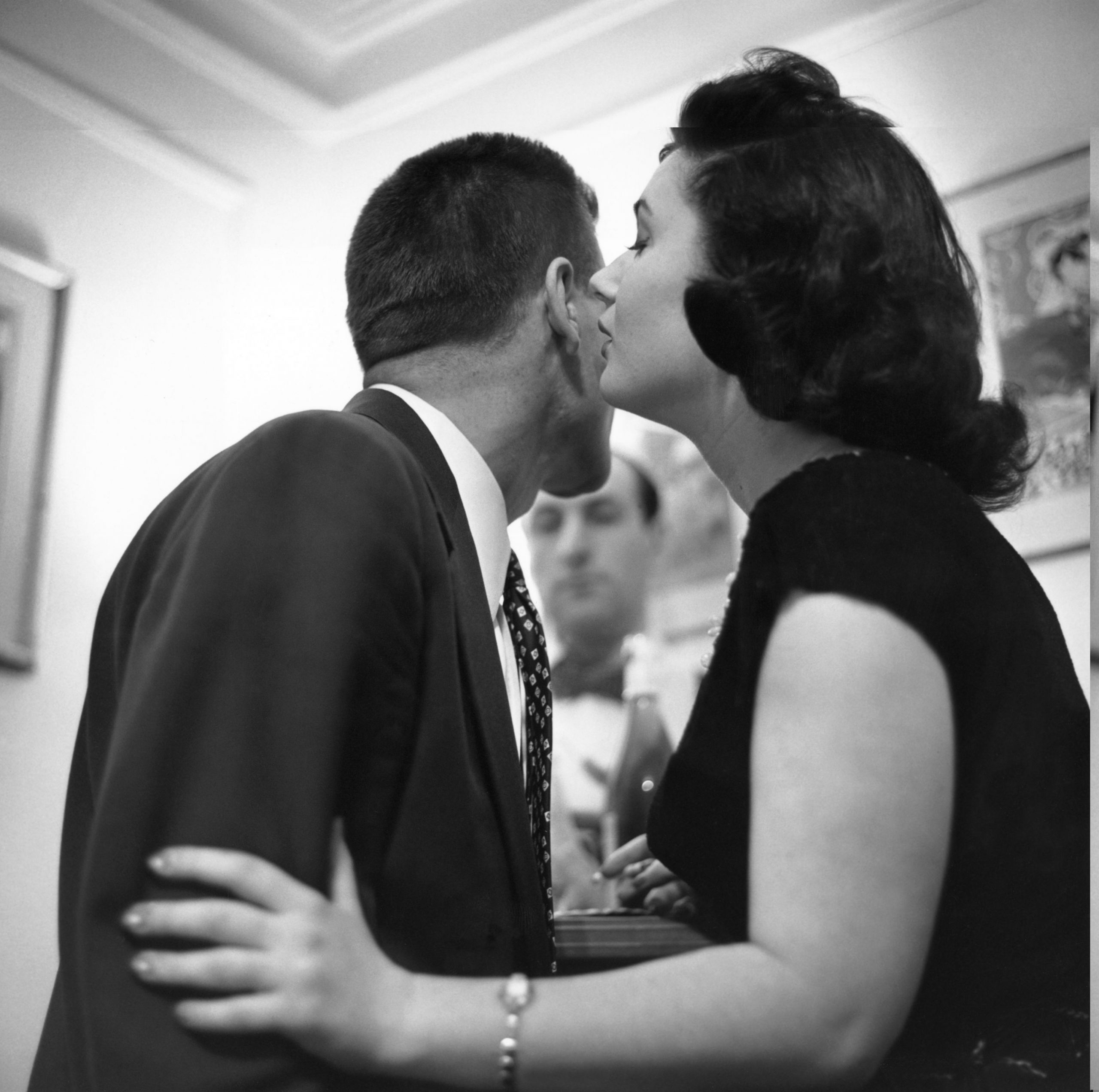
The Whispering Community: An ASMRticle
Sammi Gale takes a deep dive into the phenomenon known as ASMR, asking curators, psychologists, and ASMRtists a brain-tingling question: is it art?
In Fabric, Peter Strickland’s 2018 feature film casts a spell. And it’s designed to.
Its harpsichord-led score is interwoven into a textured soundscape. From the way the department store clerk repeats her customers’ phone numbers, we realise we have entered a world of uncanny, ritualised behaviour.
‘The whole film comes out of ASMR videos,’ Peter Strickland has said, referring to Autonomous Sensory Meridian Response, which is a tingling sensation some people experience when triggered by certain stimuli. These tingles typically begin on the scalp and move down the back of the neck and upper spine.
Strickland discovered the term ASMR around the time he was making In Fabric, though he’d experienced the sensation himself before, and produced triggering sound effects in his previous films. The Duke of Burgundy lingers on popping soap bubbles and, strangely, on the high-frequency sounds certain moths’ genitals make to throw off their approaching love rivals.
Strickland’s new short experimental film Cold Meridian explores ASMR and its online community directly. As we follow a practitioner and the enticing effect that her videos have on her viewers, the film’s stark monochrome seems at odds with the soothing sounds of hair being washed, whispered Hungarian, and paper softly rustled.
ArrayA still from Strickland’s Cold Meridian
The term ‘ASMR’ is still relatively nascent, coined in 2010 by Jennifer Allen when she stumbled onto a thread on the Steady Health forum titled ‘Weird sensation feels good’ and found a clutch of people experiencing pleasurable tingles, just like her.
Ten years on, ‘asmr’ is the second most commonly searched term on YouTube, only behind ‘PewDiePie’, and is possibly the Internet’s largest community.
This year, Sweden’s ArkDes hosted the world’s first exhibition about ASMR in a museum, titled WEIRD SENSATION FEELS GOOD. On April 7, ArkDes broadcast a virtual preview live from Stockholm. The number of viewers tuning into this international broadcast was ‘so unimaginable that the Ashmolean [Museum] are doing a study of it,’ the exhibition curator James Taylor-Foster said. ‘It’s one of the most watched cultural events in 2020.’
Taylor-Foster saw the show as an exploratory act and described the exhibition ‘as a way of planting a flag in the ground, legitimising this topic at an international cultural level. It’s about legitimising the territory of others to take up the mantle a little bit.’
‘ASMR is the product of, and the answer to, all the questions that we’re facing in societies around the world – particularly the most developed societies,’ Taylor-Foster said. He lists ‘chronic episodes of loneliness, for one, especially among younger people, and the need for intimacy’ as examples.
‘What it means to be a citizen, what it means to engage in public and what it means to be a private person all seem to come together through ASMR,’ he said. ‘What happens when you lift something out from the screen and bring into public space?’ Does that make it art?

WEIRD SENSATION FEELS GOOD, an exhibition about ASMR. Photo: Elsa Soläng.
Maria Viktorovna, who has 2m subscribers on her Gentle Whispering YouTube channel, said: ‘An artist to me is anyone who creates something that others can find value in.’
Taylor-Foster argues the medium is a form of design that mediates between mind and body. He said: ‘It’s not purely intellectual, it’s not purely physical, it’s somewhere in between…I think ASMRtists are involved in a specific practice, in a specific medium. You could connect it to foley art [sound effects], and make all kinds of connections to existing artistic practices.’
Jay, who has over 144,000 subscribers on his ASMRctica YouTube channel, would agree. ‘It’s a combination of visual art and audio. You use your body – so it’s also a performance, somehow. I think the combination is an art form of its own.’
Dr Giulia Poerio, a psychologist at the University of Essex, conducted the world’s first study looking at physiological responses to ASMR. She categorises the response as a complex ‘aesthetic emotion’. It’s certainly comparable to making or viewing art or, say, walking in nature.
Poerio says that she has some initial data – not yet published – to suggest that people with ASMR have a greater appreciation for aesthetics. ‘There is also research to suggest that people with ASMR are also more likely to experience music-induced chills,’ she said. ‘A complex kind of aesthetic emotion in response to music, in this case, which also involves goosebumps and tingling. ASMR is related to a general ability to experience emotional complexity.’
‘We should start off by asking how we define art,’ says Shushanna, who has a quarter of a million followers on her Miss ASMR YouTube channel. ‘If we start from the very beginning, photography was not considered art. Now it is. Every viewer is going to have his or her own attitude towards each video.’ To some, Jackson Pollock produced complex art. But it’s just as fair to say that he dripped, flicked, and splashed paint on a canvas.

ASMR brings together microphones and materials.
‘What an ASMRtist is looking for is connection,’ Taylor-Foster said. ‘A genuine ASMRtist just wants you to feel relaxed and put you to sleep. That’s not a common thing among other artists. What ASMRtists do is they deplete their own ego. It’s this incredible space of care and intimacy online.’
Does this ring true for ASMRtists? Viktorovna agrees: ‘I actually found the “whispering community” back in 2010 due to a depression I had been dealing with. It helped me immensely then and I’ve always wanted to give back.’
War in Shushanna’s native Armenia birthed ruminations on why she began making videos and for whom. She said: ‘Making videos became a little bit more important, because it allowed me to get away from my problems and connect to people who are not really engaged in this whole situation […] This year was one of the first times I felt like making ASMR videos was helping me as much as my viewers.’

Shushanna has 250,000 followers on her Miss ASMR YouTube channel.
Anecdotally, many viewers watch ASMR videos as a form of self-medication against loneliness, insomnia, stress and anxiety. Not so anecdotally, Poerio’s study found that ASMR is ‘associated with reductions in heart rate comparable with mindfulness. It’s not just people going, “Oh, yeah, I’m feeling really relaxed.” Her participants’ bodies told her that same story.
The fact that Poerio found reductions in heart rate would also seem to debunk the common misconception that ASMR is somehow sexual. ‘You would expect heart rates to increase during sexual arousal,’ she said. She plans to put the myth to the test in a ‘sex lab’ at the University of Essex by using a device to measure how engorged test subjects’ genitalia become when they listen to ASMR.
People who respond to ASMR often experience their first tingles in childhood. Jay recalls being triggered as a youth while pouring over maps with another person. For Shushanna, her early experiences involved playing with her hair, especially with friends, or having it washed and cut at a salon. An ASMR scenario not so dissimilar to the one depicted by the scissor-wielding Andrea Riseborough in the 2017 film, Battle of the Sexes.

A scissor-wielding Andrea Riseborough in the 2017 film, Battle of the Sexes.
Poerio said: ‘Because so much of this content is online, we forget that one of the most common things that induces ASMR is light touch. And we know from so much research [that] social touch, which is this kind of slow velocity touch rather than a sort of tapping type touch, is very much associated with affiliation, positive effects, relationships and those sorts of things.’
This is reminiscent of the grooming rituals of monkeys, which have also been shown to lower the heart rate and induce sleep. While Poerio is not an evolutionary psychologist, she speculated that the ASMR ‘sensation is like a synaesthetic type of experience where you can experience touch without being touched’.
For Shushanna, ‘The word can cure, I guess some people just need words.’ She references the Hippocratic Oath, a pledge doctors make to always put the patient first before entering the profession: “I will remember that there is art to medicine as well as science, and that warmth, sympathy, and understanding may outweigh the surgeon’s knife or the chemist’s drug.”
As much as ASMR provides a cure for some, it is a symptom of a more general malaise. Taylor-Foster firmly believes that ASMR connects to ‘degrading mental health, heightened anxiety, high levels of depression, high levels of insomnia, difficulties with intimacy with other human beings.’ For him, that’s why it has become so popular.

ASMR is reminiscent of the grooming rituals of monkeys.
The curator sketches a timeline. In 2005, YouTube was launched, with the tagline: broadcast yourself. In 2007, two years before Allen started her research, the first iPhone was released. Now that we spend a vast proportion of our lives ‘engaging through frictionless glass surfaces,’ Taylor-Foster argues ‘the tactility of the world around us is not translated into [the space] where we spend our lives.’
He said: ‘Within this kind of hurricane what ASMR has done is taken these technologies and carved out a space for slowness, it’s carved out space for intimacy, it’s carved out a space for close-feeling, it’s carved out a space for affective connection. And for a lot of people that is enough.’
The history of ASMR predates the 21st century. Often cited as the ‘godfather of ASMR’ is Bob Ross, who died in 1995. ‘He has been a really important bridge character,’ Taylor-Foster said. ‘A lot of people from older generations, especially in the US, know Bob Ross as a TV painter. And a lot of young people, especially under the age of 20, either know him as a meme, or as an ASMRtist, because he was appropriated by the ASMR community.’

On his TV show The Joy of Painting, Ross spoke softly, sprinkling every third sentence with a positive affirmation. Beginning with an empty canvas, he would spend his time brushing, scratching, stippling – all common triggers. A half-hour later the painting would be completed, and the mind tingled.
Perhaps it’s no surprise that during a time of extreme stress and isolation, a great number of people would look to a mode of digital interaction which facilitates intimacy and relaxation. Its community finds comfort through a willingness to be vulnerable with one another. Touching through a frictionless glass surface might not be a magical act, but it is certainly a euphoric one.
In the words of Bob Ross, ‘Go out on a limb – that’s where the fruit is.’




